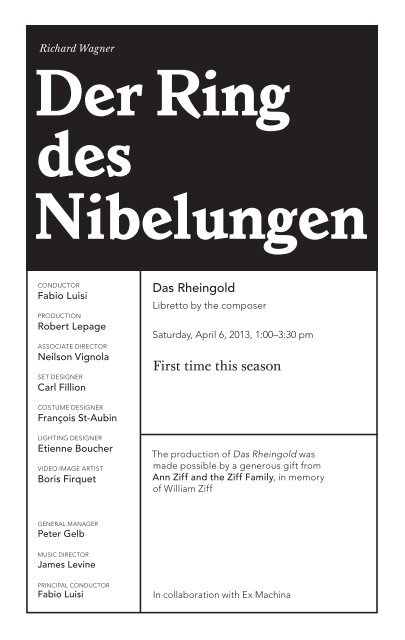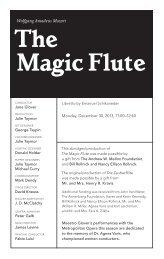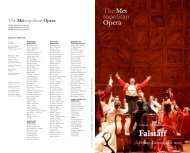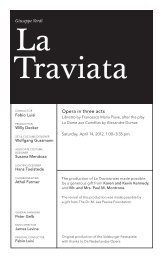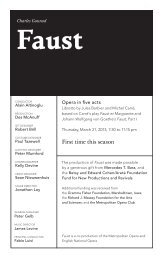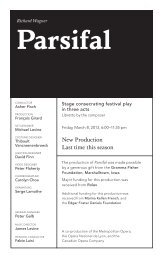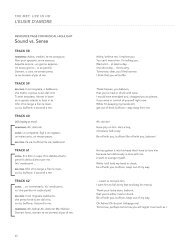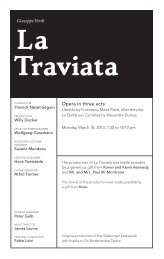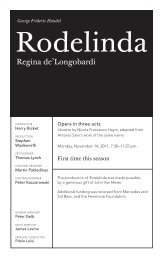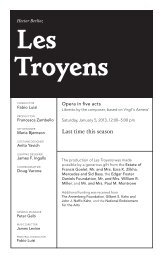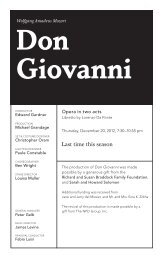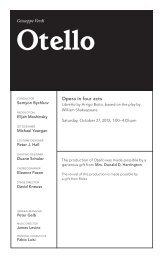Das Rheingold - Metropolitan Opera
Das Rheingold - Metropolitan Opera
Das Rheingold - Metropolitan Opera
Create successful ePaper yourself
Turn your PDF publications into a flip-book with our unique Google optimized e-Paper software.
Richard Wagner<br />
Der Ring<br />
des<br />
Nibelungen<br />
CONDUCTOR<br />
Fabio Luisi<br />
PRODUCTION<br />
Robert Lepage<br />
ASSOCIATE DIRECTOR<br />
Neilson Vignola<br />
SET DESIGNER<br />
Carl Fillion<br />
COSTUME DESIGNER<br />
François St-Aubin<br />
LIGHTING DESIGNER<br />
Etienne Boucher<br />
VIDEO IMAGE ARTIST<br />
Boris Firquet<br />
GENERAL MANAGER<br />
Peter Gelb<br />
MUSIC DIRECTOR<br />
James Levine<br />
PRINCIPAL CONDUCTOR<br />
Fabio Luisi<br />
<strong>Das</strong> <strong>Rheingold</strong><br />
Libretto by the composer<br />
Saturday, April 6, 2013, 1:00–3:30 pm<br />
First time this season<br />
The production of <strong>Das</strong> <strong>Rheingold</strong> was<br />
made possible by a generous gift from<br />
Ann Ziff and the Ziff Family, in memory<br />
of William Ziff<br />
In collaboration with Ex Machina
This performance<br />
is being broadcast<br />
live over The<br />
Toll Brothers–<br />
<strong>Metropolitan</strong> <strong>Opera</strong><br />
International Radio<br />
Network, sponsored<br />
by Toll Brothers,<br />
America’s luxury<br />
homebuilder ® , with<br />
generous long-term<br />
support from<br />
The Annenberg<br />
Foundation, The<br />
Neubauer Family<br />
Foundation, the<br />
Vincent A. Stabile<br />
Endowment for<br />
Broadcast Media,<br />
and contributions<br />
from listeners<br />
worldwide.<br />
This performance is<br />
also being broadcast<br />
live on <strong>Metropolitan</strong><br />
<strong>Opera</strong> Radio on<br />
SiriusXM channel 74.<br />
2012–13 Season<br />
The 165th <strong>Metropolitan</strong> <strong>Opera</strong> performance of<br />
Richard Wagner’s<br />
<strong>Das</strong><br />
<strong>Rheingold</strong><br />
conductor<br />
Fabio Luisi<br />
in order of vocal appearance<br />
Woglinde<br />
Dísella Làrusdóttir<br />
Wellgunde<br />
Jennifer Johnson Cano*<br />
Flosshilde<br />
Renee Tatum**<br />
Alberich<br />
Eric Owens<br />
Fricka<br />
Stephanie Blythe*<br />
Wotan<br />
Mark Delavan<br />
Freia<br />
Wendy Bryn Harmer*<br />
Fasolt<br />
Franz-Josef Selig<br />
Saturday, April 6, 2013, 1:00–3:30 pm<br />
Fafner<br />
Hans-Peter König<br />
Froh<br />
Richard Cox<br />
Donner<br />
Dwayne Croft*<br />
Loge<br />
Stefan Margita<br />
Mime<br />
Gerhard Siegel<br />
Erda<br />
Meredith Arwady
Musical Preparation John Keenan, Robert Morrison, Howard Watkins,<br />
Carrie-Ann Matheson, Carol Isaac, and John Fisher<br />
Assistant Stage Directors David Kneuss, J. Knighten Smit, and Paula Williams<br />
German Coach Marianne Barrett<br />
Prompter Carol Isaac<br />
Scenery, properties, and electrical props constructed and painted by Scène<br />
Éthique (Varennes, Québec) and <strong>Metropolitan</strong> <strong>Opera</strong> Shops<br />
Costumes executed by Atelier de couture Sonya B. (Montréal, Québec) and<br />
<strong>Metropolitan</strong> <strong>Opera</strong> Costume Department<br />
Wigs executed by <strong>Metropolitan</strong> <strong>Opera</strong> Wig Department<br />
EX MACHINA PRODUCTION STAFF<br />
Artistic Consultant Rebecca Blankenship<br />
Interactive Content Designers Réalisations.net<br />
Production Manager Bernard Gilbert, Assistant Viviane Paradis<br />
Technical Director Michel Gosselin, Assistant Eric Gautron<br />
Automation Designer Tobie Horswill<br />
Video Project Manager Catherine Guay<br />
Special Effects Integrator Philippe Jean<br />
Initial Interactive Video Designer Holger Förterer<br />
Properties Project Manager Stéphane Longpré<br />
Rig & Safety Adviser Guy St-Amour<br />
Costume Project Manager Charline Boulerice, Assistant Jessica Poirier-Chang<br />
Rehearsal Stage Manager Félix Dagenais<br />
Production Coordinators Vanessa Landry-Claverie, Nadia Bellefeuille<br />
Producer Michel Bernatchez<br />
This production uses flash effects.<br />
Projectors provided by Panasonic<br />
Projection technology consultants Scharff Weisberg<br />
Additional projection equipment Christie Digital<br />
This performance is made possible in part by public funds from the New York State<br />
Council on the Arts.<br />
Before the performance begins, please switch off cell phones and other electronic devices.<br />
Latecomers will not be admitted during the performance.<br />
* Graduate of the Lindemann Young Artist Development Program<br />
** Member of the Lindemann Young Artist Development Program<br />
KEN HOWARD/METROPOLITAN OPERA
34<br />
Synopsis<br />
In mythical times. In the depths of the Rhine, the Rhinemaidens Woglinde,<br />
Flosshilde, and Wellgunde laugh and play as they swim. Their singing attracts<br />
the dwarf Alberich, who clumsily tries to catch them, to their amusement.<br />
Suddenly a beam of sunlight falls into the water, creating a golden glow. The<br />
Rhinemaidens joyfully swim around it while Alberich, dazzled by the sight, asks<br />
them what it is. The girls tell him about the Rhinegold, a treasure of immeasurable<br />
value, and explain that whoever wins it will gain power over the world, but to do<br />
so he must renounce love. Frustrated by his unsuccessful attempts to catch one<br />
of the girls, the ugly dwarf curses love and steals the gold.<br />
High on a mountain, Fricka, the goddess of marriage, wakes her husband,<br />
Wotan, lord of the gods. Delighted, he looks at their newly built castle visible<br />
in the distance, but Fricka reproaches him: Wotan has promised her sister Freia,<br />
goddess of youth, to the giants Fasolt and Fafner in return for building the<br />
fortress. Suddenly Freia runs in, pursued by the giants, who demand payment.<br />
Wotan manages to hold them back with the help of the gods Donner and Froh,<br />
Freia’s brothers, who rush in to help. Finally Loge, the demigod of fire, appears.<br />
He cleverly suggests an alternative payment: the ring that Alberich has forged<br />
from the Rhinegold and all the other treasures he has accumulated. The giants<br />
agree, dragging Freia off as hostage. With the youth goddess gone, the gods<br />
suddenly begin to age. Wotan and Loge hurry down through the earth to find<br />
Alberich.<br />
In Nibelheim, the underground home of the Nibelungs, Alberich forces his<br />
timid brother Mime to give him the Tarnhelm, a magic helmet Mime has made<br />
that transforms its wearer into any shape and that can carry him anywhere in a<br />
second. Alberich tries it on, turns invisible and torments Mime before going off<br />
to terrorize the other dwarfs he has enslaved to work for him. Wotan and Loge<br />
arrive, and Mime tells them about Alberich’s cruel dictatorship. Reappearing,<br />
Alberich mocks the gods and threatens to conquer the world and enslave them.<br />
Loge asks for a demonstration of the Tarnhelm and Alberich obliges, turning<br />
himself first into a serpent, then into a toad, which the gods capture easily. Loge<br />
snatches the Tarnhelm, and as Alberich is transformed back into his real self the<br />
gods bind him and drag him off.<br />
Back on the mountain, Alberich is forced to summon the Nibelungs to heap<br />
up the gold for Freia’s ransom. Loge keeps the Tarnhelm—and Wotan wants<br />
the ring. Alberich says he would rather die than give it up, but Wotan wrests it<br />
from his finger, suddenly overcome with lust for its power. Alberich is shattered.<br />
Freed and powerless, he curses the ring: ceaseless worry and death shall be the<br />
destiny of all who possess it. After the dwarf has left, Fricka, Donner, and Froh
welcome back Wotan and Loge, who show them the pile of gold. The giants<br />
return with Freia. Fasolt, who loves the girl, agrees to accept the gold only if<br />
it completely hides her from his view. Froh and Loge pile up the treasure and<br />
even give up the Tarnhelm, but Fasolt can still see Freia’s eye through a crack.<br />
Fafner demands the ring to close it. When Wotan refuses, the giants start to<br />
carry Freia off. They are stopped by the sudden appearance of Erda, goddess<br />
of the earth, who warns Wotan that possession of the ring will bring about the<br />
end of the gods. Wotan tries to learn more and questions her, but she vanishes.<br />
He decides to follow her advice and throws the ring on the hoard. Alberich’s<br />
curse immediately claims its first victim as Fafner kills his brother in a dispute<br />
over the treasure. The gods are horrified. Donner clears the air with thunder<br />
and lightning and a rainbow appears, forming a bridge to the castle that Wotan<br />
names Valhalla. As the voices of the Rhinemaidens echo from the valley below,<br />
lamenting the loss of the Rhinegold, the gods walk toward their new home. Only<br />
Loge stays behind, mocking their pride.<br />
Remembering Risë Stevens<br />
June 11, 1913 – March 20, 2013<br />
Shortly after this issue of Playbill had gone<br />
to press, the Met family was saddened by<br />
the news of the death of mezzo-soprano<br />
Risë Stevens, just shy of her 100th birthday<br />
(an event we were looking forward to<br />
celebrating in the front of this program).<br />
A consummate artist, treasured colleague,<br />
and devoted supporter of the company for<br />
75 years, Stevens sang 337 performances with<br />
the Met, most frequently in the title role of<br />
Carmen and as Octavian in Der Rosenkavalier (pictured). After her retirement<br />
from the stage in 1961, she continued her work as a tireless advocate for both the<br />
company and for opera as an art form, serving as director of the <strong>Metropolitan</strong><br />
<strong>Opera</strong> National Company and of the National Council Auditions, advisor<br />
to the Young Artist Development Program, and a managing director on the<br />
Met’s board. We extend our sincerest condolences to her family and her many<br />
friends and admirers.<br />
PHOTO: ANNEMARIE HEINRICH / MET OPERA ARCHIVES<br />
35
36<br />
In Focus<br />
Richard Wagner<br />
Der Ring des Nibelungen<br />
Premiere: Bayreuth Festival House, 1876<br />
The Ring is a four-day saga depicting the passing of the Old Age of gods,<br />
giants, dwarves, dragons, and nature spirits, and the dawning of the Age of<br />
Man. Wagner, who wrote his own librettos, created a new musical-dramatic<br />
vocabulary to tell this story: characters, things, and ideas are represented by<br />
leitmotifs, or “leading motives,” musical themes that are continually developed<br />
and transformed over the course of the cycle. The Ring’s artistic scope is vast<br />
and the musical and aesthetic implications are endless and varied. At its core,<br />
however, it is a drama driven by the actions of a handful of memorable characters.<br />
Chief among these are Wotan, lord of the gods, whose ideals are loftier than<br />
his methods; the magnificently evil dwarf Alberich, the Nibelung of the title; the<br />
loving twins Siegmund and Sieglinde; their savage child Siegfried; and, perhaps<br />
above all, the Valkyrie Brünnhilde, who encompasses both humanity and divinity.<br />
The Creator<br />
Richard Wagner (1813–1883) was the complex, controversial creator of music–<br />
drama masterpieces that stand at the center of today’s operatic repertory. Born<br />
in Leipzig, Germany, he was an artistic revolutionary who reimagined every<br />
supposition about music and theater. Wagner insisted that words and music<br />
were equals in his works. This approach led to the idea of the Gesamtkunstwerk,<br />
or “total work of art,” combining music, poetry, architecture, painting, and other<br />
disciplines, a notion that has had an impact on creative fields far beyond opera.<br />
The Setting<br />
The drama of the Ring unfolds in a mythical world, at the center of which is<br />
the Rhine river as the embodiment of nature. In the first part of the cycle, <strong>Das</strong><br />
<strong>Rheingold</strong>, the settings are remote and otherwordly: ethereal mountaintops and<br />
caves deep under the earth. Throughout the subsequent operas, the locations<br />
gradually become more familiar as parts of the human world, with only nature<br />
(the Rhine) continuing seamlessly over time.<br />
<strong>Das</strong> <strong>Rheingold</strong>: The Music<br />
The score of <strong>Das</strong> <strong>Rheingold</strong> may be the least familiar of the four Ring operas—<br />
there are no set pieces appropriate for concert performance, such as the<br />
Ride of the Valkyries from Die Walküre or Siegfried’s Rhine Journey from<br />
Götterdämmerung. Yet it contains some of the most striking music in Wagner’s<br />
vast output. The uniqueness of this score is apparent from the opening bars—an
exploration of an E-flat major chord that evolves for almost four minutes before<br />
finally bursting into melody. Dramatically, this is a concise musical depiction of<br />
creation, from undifferentiated primordial matter to evolution and diversification<br />
and finally, with the appearance of the Rhinemaidens, speech. A number of<br />
deft touches keep recognizably human elements at the center of the Ring’s<br />
philosophy, among them the bright and delightful music for the Rhinemaidens,<br />
which describes the primal innocence of nature, and the doltish giant Fasolt’s<br />
lyrical music as he longs for the love of the beautiful goddess Freia. Among the<br />
highly unusual effects in the score are the cacophonously rhythmic anvils in the<br />
dramatic “descent into Nibelheim” interlude that separates Scenes 2 and 3, and<br />
the six harps depicting the churning waves of the Rhine in the monumental finale.<br />
The Ring at the Met<br />
Die Walküre was the first segment of the Ring to be heard at the Met, in 1885,<br />
during the company’s second season. Leopold Damrosch conducted a cast that<br />
included two veterans of the Bayreuth Festival, Amalie Materna and Marianne<br />
Brandt. After Damrosch’s death, the remaining Ring operas received their<br />
American premieres at the Met between 1887 and 1889, conducted by Wagner’s<br />
former assistant at Bayreuth, Anton Seidl. The complete cycle was presented<br />
eight times in the spring of 1889, including tour performances in Philadelphia,<br />
Boston, Milwaukee, Chicago, and St. Louis. The uncut cycles conducted by<br />
Franz Schalk in 1898–99 began a sequence of 19 consecutive seasons with<br />
Ring cycles. Performances resumed after World War I in 1924–25, conducted<br />
by Artur Bodanzky, and continued without interruption until 1945. A production<br />
designed by Lee Simonson, first seen in 1947–48, had a short life and was<br />
succeeded, beginning in 1967, by a new staging directed and conducted by<br />
Herbert von Karajan, with sets by Günther Schneider-Siemssen, that originated<br />
at the Salzburg Easter Festival. It was not completed until 1974–75, without<br />
Karajan, and then had only three cycle performances. Otto Schenk’s production,<br />
with new designs by Schneider-Siemssen, was introduced over three seasons<br />
beginning with Die Walküre on Opening Night 1986. The complete cycle was<br />
first seen in the spring of 1989 and made its final appearance in the 2008–09<br />
season. All 21 cycles of the Schenk production were conducted by James Levine.<br />
The current staging by Robert Lepage, the eighth in the history of the Met, was<br />
unveiled with the premiere of <strong>Das</strong> <strong>Rheingold</strong>, again conducted by Maestro<br />
Levine, on Opening Night of the 2010–11 season.<br />
Met Titles<br />
To activate, press the red button to the right of the screen in front of your seat and follow the<br />
instructions provided. To turn off the display, press the red button once again. If you have questions<br />
please ask an usher at intermission.<br />
37
Program Note<br />
In all of Western culture there is nothing quite like Richard Wagner’s Der<br />
Ring des Nibelungen (“The Ring of the Nibelung”). Based on Wagner’s<br />
own retelling of stories from ancient German and Icelandic mythology, it<br />
consists of four separate but intimately related operas—some of them among<br />
the longest ever written—usually performed over the space of a week.<br />
<strong>Das</strong> <strong>Rheingold</strong> is the first chapter in this epic tale, and it is—quite unfairly—<br />
sometimes not given the respect accorded other parts of the Ring. For one thing,<br />
it is by far the shortest. At two and a half hours it is one of Wagner’s shortest<br />
operas, about the same length as Der Fliegende Holländer. The composer<br />
himself inadvertently contributed to this slighting of <strong>Rheingold</strong> by calling it a<br />
“preliminary evening” to the rest of the Ring.<br />
After finishing Lohengrin in 1848, Wagner wrote the libretto—or, as he<br />
liked to say, poem—to a new opera, Siegfried’s Death (known today as<br />
Götterdämmerung). Realizing that he needed to explain how the events of that<br />
opera had come to be, he added Young Siegfried (the opera we now know as<br />
Siegfried) in 1851. The following year, feeling further explanation was needed,<br />
he finished the libretto of Die Walküre.<br />
“In order to give everything completely, these three dramas must be<br />
preceded by a grand introductory play: The Rape of the <strong>Rheingold</strong>,” Wagner<br />
wrote to Franz Liszt. “The object is the complete representation of everything<br />
in regard to this rape: the origin of the Nibelung treasure, the possession of<br />
this treasure by Wotan, and the curse of Alberich…. [By writing this separate<br />
drama] I gain sufficient space to intensify the wealth of relationship, while in the<br />
previous mode of treatment I was compelled to cut down and enfeeble this.”<br />
While Wagner was creating the libretto to his stupendous new work, he was<br />
also writing books and pamphlets—on theatrical reform, on opera and drama,<br />
and the artwork of the future. As his ideas on the nature of opera changed, so<br />
did the nature of his libretti. Götterdämmerung has marvelous monologues, a<br />
thrilling love duet, a sensational vengeance trio—all of which can be excerpted<br />
and performed on their own (as can some of the orchestral passages). By<br />
the time Wagner had arrived at <strong>Das</strong> <strong>Rheingold</strong> in 1852, he had come to the<br />
conclusion that the drama should not be interrupted by musical set pieces but<br />
ought to unfold seamlessly.<br />
The vocal writing therefore had to be different from the way singers had<br />
been treated in operas before. At the same time, the orchestra would become<br />
as much an integral part of conveying the drama as the soloists onstage. “The<br />
music shall sound in such a fashion that people shall hear what they cannot<br />
see,” Wagner wrote to Liszt. In fact, sketches show that as Wagner was in the<br />
preliminary stages of composition he was not only thinking of the words, but<br />
of the stage directions as well, writing music that reflected the movement of<br />
the scene.<br />
39
40<br />
Program Note CONTINUED<br />
In order to realize his new conception of music drama, Wagner developed<br />
the system of leitmotifs—short segments of melody, rhythm, or harmony that<br />
are associated with a character, a dramatic event, an object, or an emotion.<br />
Beginning with <strong>Rheingold</strong>, Wagner’s music springs almost entirely from these<br />
building blocks, which he molds or combines to reflect shifts in the drama on<br />
stage. But his leitmotifs are much more than mere musical “sign posts.” They<br />
can let the audience know what a character is thinking or why an event is taking<br />
place. Musical motifs relating to specific characters or situations were nothing<br />
new in opera at the time, but the degree to which Wagner employed this idea<br />
had no precedent. “I am spinning my cocoon like a silkworm,” he wrote to Liszt<br />
as he was working on <strong>Rheingold</strong>, “but I spin it out of myself.” (Though the libretti<br />
to the Ring operas were written in reverse order, the music was composed from<br />
the beginning of the cycle to the end.)<br />
One of the most difficult tasks Wagner faced was how to begin <strong>Das</strong><br />
<strong>Rheingold</strong>. What kind of music could possibly launch not just this opera, but the<br />
entire Ring cycle? He later related the events that inspired the creation of the<br />
prelude (as always with Wagner, his reminiscences are to be taken with a grain<br />
of salt). He had gone for a long walk, then returned to take a nap. Falling into<br />
a state of half-sleep, he suddenly felt as if he were sinking into a flood of water:<br />
“The rush and roar soon took musical shape within my brain as the chord of<br />
E-flat major, surging incessantly in broken chords: these declared themselves as<br />
melodic figurations of increasing motion, yet the pure triad of E-flat major never<br />
changed…. I awoke from my half-sleep in terror, feeling as though the waves<br />
were now rushing high above my head. I at once recognized that the orchestral<br />
prelude to the <strong>Rheingold</strong>, which for a long time I must have carried about within<br />
me, yet had never been able to fix definitely, had at last come into being in me:<br />
and I quickly understood the very essence of my own nature: the stream of life<br />
was not to flow to me from without, but from within.”<br />
There is nothing in all of opera like this miraculous beginning: a low E flat<br />
softly played by the doubles basses, then, four measures later, a B flat added<br />
by the bassoons. Another 12 measure later a single French horn (“very sweetly”<br />
says the score) intones the notes of the E-flat major triad up the scale for over<br />
two octaves, followed by a second horn, then another, until all eight horns are<br />
playing waves of arpeggios, all on the three notes of the E-flat major triad. Then<br />
the cellos and eventually the entire orchestra join in. It’s a musical depiction of<br />
the creation of life, growing from a single cell. At the climax, the Rhinemaidens<br />
suddenly break into song—representing joyous, unspoiled nature itself.<br />
In addition to writing music unlike anything heard before, with the Ring<br />
Wagner was making demands on the physical stage that went beyond what<br />
seemed even possible at the time: the opening scene of the Rhinemaidens<br />
swimming around as if in mid-air; the shift from the depths of the Rhine to the
airy mountaintops of the gods, with Valhalla seen in the distance; the descent to<br />
Nibelheim and the journey back; Donner, the god of thunder, summoning the<br />
swirling mists, then dissipating them on cue with his hammer, conjuring up a<br />
rainbow bridge over which the gods would walk to their new home…<br />
Wagner eventually overcame all the musical, scenic, and dramatic challenges<br />
he had created. The fact that he not only managed to do so, but that the whole<br />
of the Ring cycle seems to flow effortlessly from <strong>Das</strong> <strong>Rheingold</strong>, raises its stature<br />
from a mere prologue to a theatrical masterpiece all on its own.<br />
Wagner did not wish for any part of the Ring to be staged until the cycle<br />
could be presented as a whole. He realized this would require a “great festival,<br />
to be arranged perhaps especially for the purpose of this performance,” as he<br />
had already mentioned to Liszt before a note of the music had been written.<br />
But against Wagner’s wishes, <strong>Das</strong> <strong>Rheingold</strong> had its premiere in Munich on<br />
September 22, 1869, on the express orders of the composer’s ardent admirer<br />
and patron, King Ludwig II. Another seven years would pass before Wagner was<br />
able to present the Ring in its entirety, in the theater at Bayreuth that was built<br />
specifically for it (and that still serves as the home of the annual Wagner festival).<br />
<strong>Das</strong> <strong>Rheingold</strong> was first heard at the Met on January 4, 1889. The program<br />
carried a note stating that, “For this opera the scenery has been ordered from<br />
Germany and the costumes and armor are from the designs of Prof. Doepier,<br />
who made the original drawings for Richard Wagner.” The one-act opera was<br />
presented with an intermission between the second and third scenes. “This<br />
is the practice of the Imperial <strong>Opera</strong> House in Vienna, and though open to<br />
objection on artistic grounds will doubtless prove a welcome relief,” noted one<br />
New York newspaper the day before the premiere. In fact, Wagner himself had<br />
raised no objections to a break when <strong>Rheingold</strong> was given in Berlin in 1881. The<br />
Met presented the work both with and without intermission well into the 20th<br />
century. In Robert Lepage’s production, the drama unfolds in one uninterrupted<br />
act, as the composer conceived it.<br />
—Paul Thomason<br />
ADDITIONAL EX MACHINA PRODUCTION STAFF Costume and Properties Production Richard Provost,<br />
Valérie Deschênes; Wig and make up research Florence Cornet; Properties Production<br />
Atelier Sylvain Racine, Paul Duval, Boscus, Théâtre de la Dame de Cœur, Créations Fillion, Tridim;<br />
Lighting Assistants Valy Tremblay, David Lavallée; Set Designer Assistants Anna Tusell Sanchez,<br />
Santiago Martos Gonzalez<br />
WORKSHOP PERFORMERS Anne Barry, Geneviève Bérubé, Guillaume Chouinard, Michael Duffy,<br />
Andrea Legg, Guy Lessard, Jacinthe Pauzé Boisvert, Jenny Ritchie, Francis Roberge, Éric Robidoux,<br />
Martin Vaillancourt<br />
lacaserne.net<br />
Yamaha is the official piano of the <strong>Metropolitan</strong> <strong>Opera</strong>.<br />
41
42<br />
The Cast<br />
Fabio Luisi<br />
conductor (genoa, italy)<br />
this season Un Ballo in Maschera, Les Troyens, Aida, and Wagner’s Ring cycle at the Met;<br />
Don Carlo at La Scala; Jen˚ufa, Tosca, La Bohème, Rigoletto, Der Rosenkavalier, and Bellini’s<br />
La Straniera at the Zurich <strong>Opera</strong>; and concerts with the MET Orchestra at Carnegie Hall,<br />
the Vienna Symphony, and Philharmonia Zürich.<br />
met appearances Don Giovanni, Manon, La Traviata, Le Nozze di Figaro, Elektra, Hansel<br />
and Gretel, Tosca, Lulu, Simon Boccanegra, Die Ägyptische Helena, Turandot, Ariadne auf<br />
Naxos, Rigoletto, Don Carlo (debut, 2005), and the Ring cycle.<br />
career highlights He is principal conductor of the Met, chief conductor of the Vienna<br />
Symphony, and general music director of the Zurich <strong>Opera</strong>. He made his La Scala debut<br />
last season with Manon, his Salzburg Festival debut in 2003 leading Strauss’s Die Liebe der<br />
Danae (returning the following season for Die Ägyptische Helena), and his American debut<br />
with the Lyric <strong>Opera</strong> of Chicago leading Rigoletto. He also appears regularly with the Vienna<br />
State <strong>Opera</strong>, Munich’s Bavarian State <strong>Opera</strong>, and Berlin’s Deutsche Oper and Staatsoper.<br />
Meredith Arwady<br />
mezzo-soprano (kalamazoo, michigan)<br />
this season Erda in Wagner’s Ring cycle at the Met, Gertrude in Roméo et Juliette with<br />
Arizona <strong>Opera</strong>, Erda in Frankfurt, and Kathy Hagen in the world premiere of Terence<br />
Blanchard’s Champion with <strong>Opera</strong> Theatre of St. Louis.<br />
met appearances The Marquise of Berkenfield in La Fille du Régiment and Pasqualita in<br />
Doctor Atomic (debut, 2008).<br />
career highlights Recent performances include Auntie in Peter Grimes with the Houston<br />
Grand <strong>Opera</strong>, Stravinsky’s The Nightingale and other Short Fables with the Canadian<br />
<strong>Opera</strong> Company and at Brooklyn Academy of Music, the title role of Vivaldi’s Griselda<br />
with Santa Fe <strong>Opera</strong>, and Cornelia in Giulio Cesare at the Fort Worth <strong>Opera</strong> Festival.<br />
She has also sung the Abbess in Suor Angelica, Zita in Gianni Schicchi, and the Marquise<br />
of Berkenfield with the San Francisco <strong>Opera</strong>, Ulrica in Un Ballo in Maschera in Frankfurt,<br />
Pasqualita with the English National <strong>Opera</strong> and Lyric <strong>Opera</strong> of Chicago, and Myrtle Bagot<br />
in the world premiere of Previn’s Brief Encounter with the Houston Grand <strong>Opera</strong>.
Stephanie Blythe<br />
mezzo-soprano (mongaup valley, new york)<br />
this season Ulrica in Un Ballo in Maschera, Azucena in Il Trovatore, and Fricka in<br />
<strong>Das</strong> <strong>Rheingold</strong> and Die Walküre at the Met, and a U.S. tour culminating in a recital at<br />
Carnegie Hall.<br />
met appearances More than 150 performances of 25 roles including Orfeo in Orfeo ed<br />
Euridice, Eduige in Rodelinda, Amneris in Aida, Ježibaba in Rusalka, Ulrica, Cornelia in<br />
Giulio Cesare, Jocasta in Oedipus Rex, Mistress Quickly in Falstaff, Baba the Turk in The<br />
Rake’s Progress, and the Alto Solo in Parsifal (debut, 1995).<br />
career highlights Azucena for her debut at the San Francisco <strong>Opera</strong> and in concert for<br />
her debut with the Deutsche Oper Berlin, Baba the Turk at Covent Garden, Orlofsky<br />
in Die Fledermaus at the Arizona <strong>Opera</strong>, Dalila in Samson et Dalila at the Pittsburgh<br />
<strong>Opera</strong>, Isabella in L’Italiana in Algeri and Carmen in Seattle, Azucena and Mistress<br />
Quickly at Covent Garden, Isabella in Philadelphia and Santa Fe, and Cornelia and<br />
Mistress Quickly at the Paris <strong>Opera</strong>. She is a graduate of the Met’s Lindemann Young<br />
Artist Development Program.<br />
Wendy Bryn Harmer<br />
soprano (roseville, california)<br />
this season Freia in <strong>Das</strong> <strong>Rheingold</strong>, Ortlinde in Die Walküre, and Gutrune in<br />
Götterdämmerung at the Met; and Freia, Gerhilde in Die Walküre, and Gutrune for her<br />
debut at the Seattle <strong>Opera</strong>.<br />
met appearances Emma in Khovanshchina, the First Lady in The Magic Flute, Chloë in The<br />
Queen of Spades, the Third Norn in Götterdämmerung, First Bridesmaid in Le Nozze<br />
di Figaro (debut, 2005), a Flower Maiden in Parsifal, Baˇrena in Jenu˚ fa, a Servant in Die<br />
Ägyptische Helena, and Dunyasha in War and Peace.<br />
career highlights Recent performances include Glauce in Cherubini’s Medea for her debut<br />
at the Glimmerglass <strong>Opera</strong>, Wanda in Offenbach’s La Grande-Duchesse de Gérolstein<br />
and Vitellia in La Clemenza di Tito with <strong>Opera</strong> Boston, Adalgisa in Norma at the Palm<br />
Beach <strong>Opera</strong>, Mimì in La Bohème at the Utah <strong>Opera</strong> Festival, and Gerhilde for her debut<br />
with the San Francisco <strong>Opera</strong>. She is a graduate of the Met’s Lindemann Young Artist<br />
Development Program.<br />
43
44<br />
The Cast CONTINUED<br />
Mark Delavan<br />
baritone (princeton, new jersey)<br />
this season Gianciotto in Francesca da Rimini and Wotan in Wagner’s Ring cycle at the<br />
Met, the title role of Rigoletto with Pittsburgh <strong>Opera</strong>, and Scarpia in Tosca with the San<br />
Francisco <strong>Opera</strong>.<br />
met appearances Tomsky in The Queen of Spades, Amonasro in Aida (debut, 2001), Gérard<br />
in Andrea Chénier, Don Carlo in La Forza del Destino, the Messenger in Die Frau ohne<br />
Schatten, Scarpia in Tosca, Nabucco, Rigoletto, and Simon Boccanegra.<br />
career highlights Recent performances include Wotan and the Wanderer in Ring<br />
performances with the San Francisco <strong>Opera</strong> and Deutsche Oper Berlin, Scarpia with the<br />
Canadian <strong>Opera</strong> Company and Pittsburgh <strong>Opera</strong>, and Mandryka in Arabella with the Santa<br />
Fe <strong>Opera</strong>. He has also sung Jupiter in Strauss’s Die Liebe der Danae with the Deutsche<br />
Oper Berlin, Renato in Un Ballo in Maschera for Lyric <strong>Opera</strong> of Chicago, Iago in Otello<br />
with the Deutsche Oper Berlin and <strong>Opera</strong> Company of Philadelphia, and Jochanaan in<br />
Salome at Barcelona’s Liceu.<br />
Hans-Peter König<br />
bass (düsseldorf, germany)<br />
this season Fafner, Hunding, and Hagen in Wagner’s Ring cycle at the Met and with<br />
Munich’s Bavarian State <strong>Opera</strong>, Orest in Elektra and the Commendatore in Don Giovanni<br />
in Düsseldorf, Heinrich in Lohengrin in Munich, King Marke in Tristan und Isolde and<br />
Heinrich with the Deutsche Oper Berlin, and Hagen with the Paris <strong>Opera</strong>.<br />
met appearances Sarastro in Die Zauberflöte (debut, 2010) and Daland in Der Fliegende<br />
Holländer.<br />
career highlights A member of Düsseldorf’s Deutsche Oper am Rhein, he was awarded the<br />
title of Kammersänger there for his outstanding contributions to music. His wide-ranging<br />
repertoire encompasses leading bass roles of Wagner, Verdi, Mozart, Tchaikovsky, and<br />
Strauss, among others, that he has sung with many of the world’s leading opera companies.<br />
He has appeared at a guest artist at opera houses and festivals including Covent Garden,<br />
the Bayreuth Festival, Baden-Baden Festival, La Scala, Deutsche Oper Berlin, Barcelona’s<br />
Liceu, Florence’s Maggio Musicale, and Munich’s Bavarian State <strong>Opera</strong>, as well as in<br />
Dresden, Tokyo, Hamburg, and São Paulo.
Stefan Margita<br />
tenor (košice, slovakia)<br />
this season Loge in <strong>Das</strong> <strong>Rheingold</strong> at the Met and with Munich’s Bavarian State <strong>Opera</strong>, Laca<br />
in Jenu˚ fa in Munich, and the Drum Major in Wozzeck at the Deutsche Staatsoper Berlin.<br />
met appearances Filka Morozov in From the House of the Dead (debut, 2009).<br />
career highlights He has sung Laca at Paris’s Châtelet, Munich’s Bavarian State <strong>Opera</strong>,<br />
Deutsche Staatsoper and Deutsche Oper in Berlin, as well as in opera houses in Florence,<br />
Tel Aviv, Prague, Liège, Montpellier, Gent, Antwerp, and Houston, and at the Glyndebourne<br />
Festival and Japan’s Saito Kinen Festival. He has also sung Shuisky in Boris Godunov in<br />
Madrid and for his debut with the Lyric <strong>Opera</strong> of Chicago; Edrisi in Szymanowski’s King<br />
Roger with Paris’s Bastille <strong>Opera</strong> and in Madrid; Filka Morozov at La Scala and in Vienna<br />
and Amsterdam; the Drum Major in Paris, Rome, and at the Saito Kinen Festival; Walther<br />
in Tannhäuser at La Scala and the San Francisco <strong>Opera</strong>; and Froh in <strong>Das</strong> <strong>Rheingold</strong> in<br />
Lisbon and Venice.<br />
Eric Owens<br />
bass-baritone (philadelphia, pennsylvania)<br />
this season Alberich in Wagner’s Ring cycle at the Met, Capellio in Bellini’s I Capuleti e i<br />
Montecchi with the San Francisco <strong>Opera</strong>, Sharpless in Madama Butterfly at the Los Angeles<br />
<strong>Opera</strong>, and concert engagements with the Seattle Symphony, Baltimore Symphony<br />
Orchestra, Detroit Symphony Orchestra, and New York Philharmonic.<br />
met appearances General Leslie Groves in Doctor Atomic (debut, 2008) and Sarastro in<br />
The Magic Flute.<br />
career highlights General Leslie Groves with the San Francisco <strong>Opera</strong> (world premiere)<br />
and Lyric <strong>Opera</strong> of Chicago, Oroveso in Norma at Covent Garden and in Philadelphia,<br />
and Fiesco in Simon Boccanegra, Don Basilio in Il Barbiere di Siviglia, and Porgy in Porgy<br />
and Bess with Washington National <strong>Opera</strong>. He has also sung Ramfis in Aida in Houston,<br />
the Speaker in Die Zauberflöte with Paris’s Bastille <strong>Opera</strong>, Rodolfo in La Sonnambula in<br />
Bordeaux, Ferrando in Il Trovatore and Colline in La Bohème in Los Angeles, the title role<br />
of Handel’s Hercules with the Lyric <strong>Opera</strong> of Chicago, and Ramfis in San Francisco.<br />
45
46<br />
The Cast CONTINUED<br />
Franz-Josef Selig<br />
bass (mayen, germany)<br />
this season Fasolt in <strong>Das</strong> <strong>Rheingold</strong> at the Met, Arkel in Pelléas et Mélisande in Essen, Rocco<br />
in Fidelio in Cologne, King Marke in Tristan und Isolde with the Canadian <strong>Opera</strong> Company,<br />
and Daland in Der Fliegende Holländer and Hunding in Die Walküre at the Bayreuth Festival.<br />
met appearances Sarastro in Die Zauberflöte (debut, 1998).<br />
career highlights Recent performances include Arkel in Madrid and at Paris’s Bastille<br />
<strong>Opera</strong>, Sarastro in Die Zauberflöte at Covent Garden, Gurnemanz in Parsifal with the<br />
Vienna State <strong>Opera</strong>, Rocco and Sarastro with Munich’s Bavarian State <strong>Opera</strong>, and the<br />
Commendatore in Don Giovanni at the Salzburg Festival. He has also sung Bartolo in<br />
Le Nozze di Figaro at the Salzburg Festival, Osmin in Die Entführung aus dem Serail in<br />
Barcelona, and King Marke in Vienna. He appears regularly at Covent Garden, La Scala,<br />
Lyric <strong>Opera</strong> of Chicago, Munich’s Bavarian State <strong>Opera</strong>, Brussels’s La Monnaie, Deutsche<br />
Oper Berlin, Paris’s Châtelet, and the Salzburg Easter Festival.<br />
Gerhard Siegel<br />
tenor (trostberg, germany)<br />
this season Mime in Wagner’s Ring cycle at the Met and Covent Garden, the Captain<br />
in Wozzeck in Stuttgart and at Madrid’s Teatro Real, and Shuisky in Boris Godunov with<br />
Munich’s Bavarian State <strong>Opera</strong>.<br />
met appearances Mime (debut, 2004) and the Captain.<br />
career highlights Herod in Salome in Brussels, Montpellier, and at the Vienna State <strong>Opera</strong>;<br />
Mime at the Bayreuth Festival, Covent Garden, and in Cologne; Max in Der Freischütz<br />
at Berlin’s Komische Oper; and Florestan in Fidelio at the Granada Festival. He has also<br />
sung the title role of Tannhäuser in Augsburg, Max in Jonny Spielt Auf in Cologne, the<br />
Captain at Paris’s Bastille <strong>Opera</strong> and in Madrid, the title role of Siegfried and Walther in<br />
Die Meistersinger von Nürnberg at the Nürnberg State Theatre, Sellem in The Rake’s<br />
Progress at the Theater an der Wien, Alwa in Lulu in Geneva and Madrid, and Schoenberg’s<br />
Gurrelieder on tour with the SWR Symphony Orchestra.


